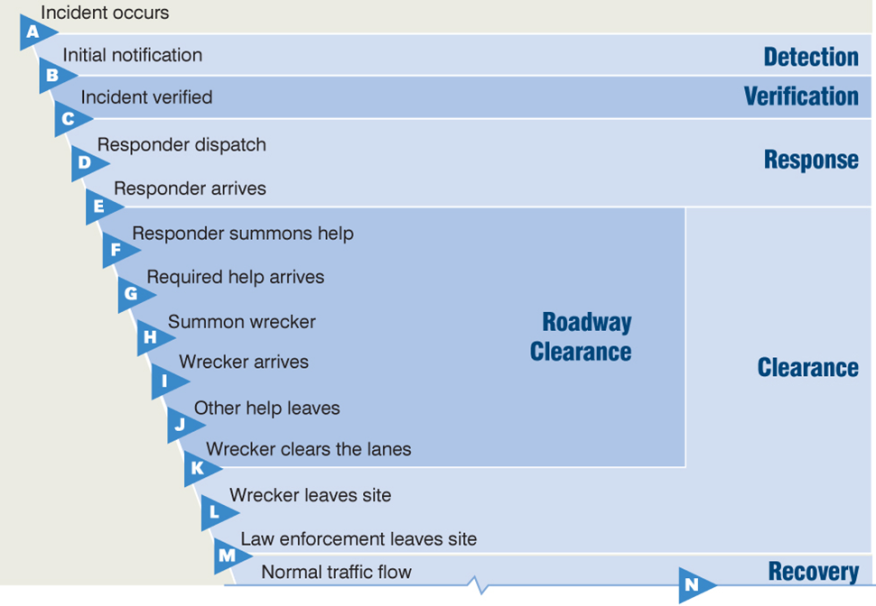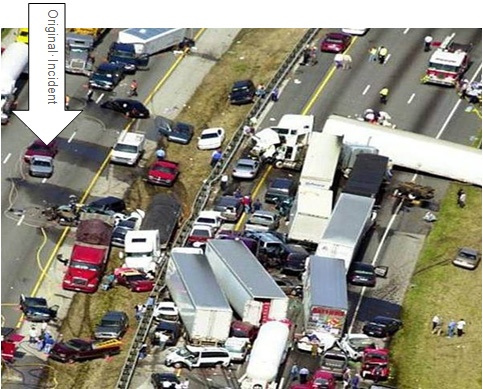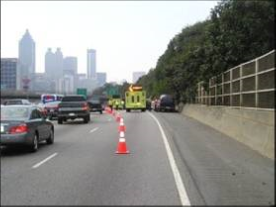
Road Network Operations
& Intelligent Transport Systems
A guide for practitioners!

Road Network Operations
& Intelligent Transport Systems
A guide for practitioners!
Traffic Incident Management (TIM) is the response to traffic accidents, incidents and other unplanned events that occur on the road network, often in potentially dangerous situations. The objective is to handle incidents safely and quickly, to prevent further accidents and restore traffic conditions back to normal as quickly as possible. It requires the deployment of a systematic, planned and coordinated set of response actions and resources.
Traffic Incident Management proceeds through a cycle of phases starting with immediate notice of possible dangers or problems ahead – as soon as an incident occurs – in order to forewarn drivers and prevent accidents.
Incident warning and management have two main goals – to:
Incident management requires planning, a response that is proportionate, safety at the scene of the incident and recovery. It requires attention to three main aspects – in order of priority – safety, mobility of traffic flow and control and repair of damage.
To understand how control strategies and network operations can reduce the negative impact of incidents, it is important to understand the timeline and different stages of incidents, as shown in the diagram below.

The diagram might represent a collision on a motorway, a spill of materials or a disabled vehicle - resulting in the need to close one or more of the running lanes. All steps will not occur in every incident - and there may be other interwoven relationships – but the diagram represents the typical sequence for most moderate-to-serious incidents. The steps are shown in a staggered fashion simply to illustrate that the incident timeline is not uniform (the time increments are relative – and not to any scale).
The duration of particular stages in the incident are represented by the letter pairs in the diagram and are listed below. For example, the duration of the incident itself would be from point A on the timeline to point M, while the total time the incident is having an effect on traffic is from A to N – with the time elapsed to point N often proportionately much longer than shown.
Common phases of an incident are:
Although not evident in the diagram, the recovery period is frequently longer than the duration of the incident itself. Incident recovery can be four-to-five times longer. This means that for every minute that can be trimmed off incident detection, verification and/or clearance, up to 5 minutes of recovery time can be saved for traffic to get back to normal.
Avoiding secondary incidents is of paramount importance because they start the incident response cycle all over again. The aerial photograph below illustrates this point. The original incident that caused the multiple vehicle pile-up was a car that was stationary due to its engine overheating – which blocked a traffic lane in the direction going “downstream”. The stationary vehicle was the cause of one or two collisions but many more collisions on both sides of the highway occurred because a vehicle responding to the incident attempted to bypass the traffic queue and reach the incident by travelling the wrong way on the opposite side. The example shows that secondary incidents can in fact be more serious than the original incident.

All agencies must work closely together to quickly detect an incident, and to verify, respond and clear it in as timely and efficient a manner as possible. ITS in general and the Traffic Control Centres (TCCs) in particular will play a part at each stage. (See Urban Operations and Highway Operations) The emphasis must be on the rigorous application of the 4-Cs of incident management (Communication, Cooperation, Coordination and Consensus) and close inter-agency working, through Traffic Incident Management (TIM) teams. Traffic Incident Management Teams and Safety Service Patrols are vital elements of a good traffic incident management programme. (See Incident Response Plans)
Clarity in assigning roles and responsibilities to the Traffic Incident Management (TIM) Team, the Mobile Safety Service Patrols and tow-truck providers during traffic incidents cannot be understated. Even though the TIM team may not be an active participant in the response to a particular incident, it has a key role to play in formulating the policies, practices and training that go into it. TIM members will include the first-line responders or organisations that provide direct support. Mobile Safety Service patrols and tow providers are also active participants. (See Mobile Patrols)
Typical use of ITS devices and the roles and responsibilities of the TCC and Mobile Safety Service Patrols are summarised in the two tables below for different stages of an incident. In these tables there is no implied sequence of actions within cells – instead they are typical actions that might be taken.
|
|
Roles and Responsibilities |
||
|
Incident Stage |
Use of ITS |
Traffic Control Centre |
Mobile Safety Service Patrol |
|
Detection |
|
|
|
|
Verification |
|
|
|
|
Response |
|
|
|
|
|
Roles and Responsibilities |
||
|
Incident Stage |
Use of ITS |
Traffic Control Centre |
Mobile Safety Service Patrol |
|
Roadway Clearance |
|
|
|
|
Incident Scene Clearance |
|
|
|
|
Recovery |
|
|
|
|
After Action |
|
|
|
Protection of personnel and field equipment from vehicle impact is of primary importance during any traffic incident or on-road emergency. Use of high-visibility vests or uniforms by incident response teams and maintenance workers should be mandatory. High-visibility markings on response vehicles and maintenance trucks helps to avoid collisions. Buffer zones around incidents or maintenance work create a safety zone – although care needs to be taken to balance safety with keeping roadway capacity available for traffic flow. Standard practice differs considerably from country to country and local practices should be followed where they exist.
All means of travel and traffic information can be used to provide timely and accurate information to travellers about the nature and location of incidents and maintenance activities (See Travel Information Systems). Automatic Incident Detection can support queue protection warnings to the approaching vehicles up-stream (See Automatic Incident Detection).
Several innovative initiatives have been used in Europe and South America, as follows:
The responders’ first priority must be the safety of themselves and the people involved in an incident. Incident scene management, particularly on high-speed roadways, often involves closures of lanes and discussions about when to re-open lanes to allow traffic to pass an active incident scene.

These decisions will be made by the incident controller (commander), who has powers to control and direct traffic (usually the police, highway or traffic patrol). ITS can assist with the decision making process. CCTV camera images – or the transfer of information from them – can be delivered to the commander either verbally or visually via tablet computer or a wireless mobile device – giving a “higher-level” view of surrounding conditions than available from the ground. Traffic and Travel Information is provided to inform drivers about lane closure status – enabling them to make more informed choices about making diversions or delaying or rerouting a trip. Less traffic helps ensure the safety of responders. (See Travel Information Systems)
Mobile Safety Service patrols play a vital role in safety. They help to manage the scene and alerting drivers who are approaching the back of the queue, help avoid secondary incidents as well as alerting passing drivers – improving the safety of the responders at the scene. VMS, Portable Dynamic Message Signs (in particular those mounted on Safety Service patrols) and other driver information delivery systems can help in providing a safe incident scene and protecting responders engaged directly in incident recovery. (See Use of VMS)
Many of the urban high-speed toll roads in South America have near total coverage by CCTV. This allows the TCC staff to monitor and record the entire response effort. These videos can later be used as a valuable training tool. CCTV also enables TCC staff to monitor upstream traffic to warn of any developing situations or to inform about secondary situations as they develop. (See CCTV)
It is sometimes difficult to determine whether a situation on the road will deteriorate into a major traffic incident or even a full-blown emergency. Some operational tasks for incident management described here may appear disproportionate to the number of incidents that occur. The crisis management checklists developed by the planning teams will help to optimise service, time and efficiency when an emergency occurs. If the impact of the incident is widespread several control centres may become involved in responding – and coordinated action will be needed. (See Incident Response Plans and Emergency Plans)